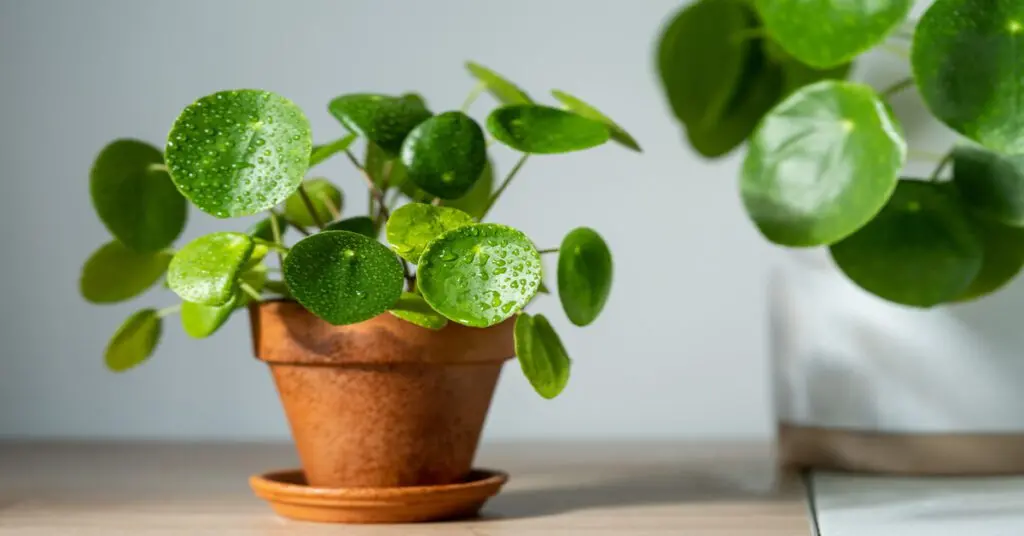Pilea peperomioides, also known as the Chinese Money Plant or Missionary Plant (among other nicknames), is a trendy indoor variety. Its low maintenance makes it sought after by gardeners of all experience levels.
Apart from its easy care, the Chinese Money Plant is loved for its appearance of playful, lily pad-like leaves and small flowers. In addition, rumor has it that it can bring good luck. So, who would want to leave this plant out of their home? Follow our care guide below if you, too, want to jump on the Chinese Money Plant bandwagon.
For a comprehensive overview, visit Pilea peperomioides – Chinese Money Plant. This is a resource and a database that is backed by NC State University, feel free to explore more plants there.
Chinese Money Plant Care
While some houseplants are notorious for being difficult, the Chinese Money or Lefse Plant is the opposite. That said, it’s ideal for first-time houseplant growers or children.
Read on to learn about the care of this houseplant, from its watering needs to how to propagate it.
Soil
Pot your Chinese Money Plant in well-draining soil. The plant does best in soil that is peat- or coir-based. Adding perlite to the soil can increase aeration and improve drainage. Ideally, aim for soil between 6.0 and 7.0 on the pH scale. To achieve the recommended well-draining mix, consider using this soil mix, which is a beautiful premium blend.
Watering
Chinese Money or UFO Plants like neither excessive nor mild watering. Water your plant when the soil begins to dry and leaves become slightly limp.
Lighting
The Pilea peperomioides best thrives in bright, indirect light. Not enough light can lead to leggy shoots. Meanwhile, too much light can burn its semi-delicate leaves.
Humidity & Temperature
The average home typically has an ideal temperature and humidity level for the Chinese Money Plant. However, refrain from placing it in an extra humid area, too dry, too hot (e.g., under a heating vent), or too cold (e.g., under an A/C vent).
Fertilizing
A basic fertilizer can do the Chinese Money Plant well during the warmer seasons. Fertilize once a month. Avoid fertilizing this plant in the colder months.
Propagation
This plant produces offshoots that, when a few inches tall, can be removed and placed in moist soil to propagate. The offshoots grow from the stem’s nodes or the root system itself. For a detailed guide on starting your first vegetable garden, see Starting Your First Vegetable Garden in North Carolina: Best Vegetables for Beginners.
To successfully propagate your plant’s offshoots, consider using a Propagation Kit that includes all the necessary tools and materials.
Diseases & Pests
Common pests include spider mites, fungus gnats, scale, and mealybugs. Spider mites feed on excess nitrogen. Overwatering can lead to nasty fungus gnats. Using old soil or a contaminated pot can lead to scale. Lastly, mealybugs can be caused by overwatering or overfertilizing your plant.
As for diseases that can arise in this plant? These include bacterial wilt disease, Rhizoctonia root rot, and manganese toxicity.
Toxicity
Fortunately, according to ASPCA, the Chinese Money Plant is non-toxic to pets. It’s also non-toxic to humans.
Chinese Money Plant Meaning
According to Chinese philosophy, the lush leaves of the Chinese Money Plant symbolize success and spiritual growth. Based on Feng Shui, one might place one of these plants in the left corner of their home to promote luck.
Pilea peperomioides Problems
Fortunately, the Pilea peperomioides isn’t incredibly sensitive. However, issues can still arise.
Leaves falling off or turning yellow can be a sign of overwatering, too much sun, or poor drainage. Drooping or curling leaves might be due to watering, lighting, or temperature issues. As for brown spots on the leaves, this can be due to overwatering or sunscald.
The latter can also signify a pest infestation. So, keep your eyes peeled for bugs.
Conclusion
The Chinese Money Plant is no doubt a popular indoor plant. It’s low maintenance, is thought to be lucky, and even has a long lifespan. So, it’s no wonder it’s such a beloved addition to the home.

